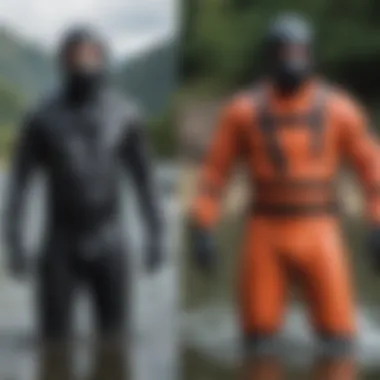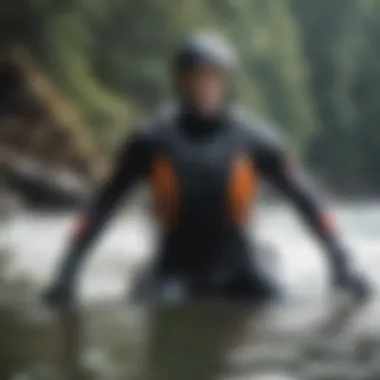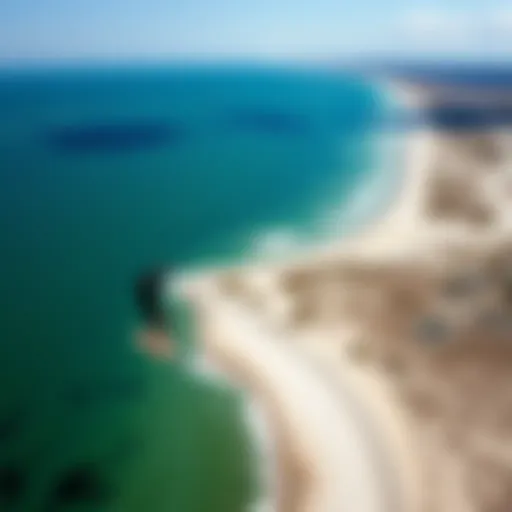Dry Suit vs Wet Suit: Key Differences for Water Sports


Intro
Water sports have become a staple of summer fun and adventure, with enthusiasts diving into activities like kiteboarding, kayaking, or just splashing around. With the rush of cold waters and sharp winds, the right attire can make or break your day on the waves. This brings us to two essential options in water gear: dry suits and wet suits. While at first glance they may seem similar, each serves a distinct purpose and offers unique benefits.
As we analyze these two types of suits, we’ll discover their specific designs, materials, and best applications. We also aim to cut through the noise and explore essential factors such as fit, maintenance, and user experience. This way, whether you're a seasoned kiteboarder or just getting your feet wet, you can make an informed decision about which suit suits your needs best.
Equipment Insights
Understanding the differences in equipment is paramount for any water sports lover. It's not just about choosing between a dry suit or a wet suit; it's about making the choice that will enhance your experience.
Latest Gear Reviews
When selecting between these suits, be sure to check for the latest models. For instance, the Kokatat Meridian Dry Suit is often heralded for its durability and features, such as Gore-Tex fabric that keeps you dry while providing breathability. On the flip side, consider the O'Neill Epic Wet Suit, noted for its flexibility and comfort, making it ideal for warmer waters. Each suit caters to specific conditions, temperatures, and personal preferences.
Don’t forget to look into user reviews and expert picks. Sometimes, word on the ground can offer insights you won’t find anywhere else. Popular forums like Reddit have various threads discussing experiences and preferences for both suits.
Essential Gear Maintenance
Caring for your water gear is crucial for longevity and performance. Here are some tips for both suit types:
- Dry Suit Care:
- Wet Suit Care:
- Rinse with fresh water after each use to prevent salt buildup.
- Check seals for wear and tear regularly.
- Store it in a cool, dry place, avoiding direct sunlight.
- Similar to dry suits, rinse after use to get rid of saltwater.
- Hang it to dry away from heat sources, which can cause damage.
- Regularly check the seams for signs of deterioration.
"The right maintenance not only prolongs the life of your gear, but it also ensures your safety and comfort in the water."
Technique Exploration
Once you’ve donned the perfect suit, mastering your technique is the next stride. While equipment is essential, your skill will elevate the overall experience.
Beginner Techniques
If you’re just starting, focus on getting comfortable in the water. Begin with simple exercises like paddling to understand how your suit performs in various conditions. Practicing in calm waters before challenging yourself with waves is crucial.
Advanced Maneuvers
For the more experienced kiteboarders, mastering maneuvers such as jumps and glides can become second nature. Here, the suit's fit and flexibility come into play. A well-fitted suit allows for a more effective range of motion, which is vital for those high-flying stunts.
Keeping your skills honed as you progress will ensure that you maximize your performance on the water and truly enjoy your adventures.
Ending
With a clearer picture of dry suits versus wet suits, you're equipped to make a choice tailored to your needs. Whether it's the insulating benefits of dry suits for cooler waters or the flexibility of wet suits for warmer climates, your comfort and safety should always be top of mind. Equip yourself wisely, and let the water sports adventures roll in!
Understanding the Basics of Water Sports Suits
Water sports suits, primarily wet suits and dry suits, play a crucial role in ensuring safety and comfort during various aquatic activities. For kiteboarders, instructors, and other enthusiasts, understanding these suits' dynamics is not just about flair or fashion; it directly influences performance and enjoyment on the water. Each suit is designed with distinct characteristics that cater to various environmental conditions. Knowing these differences can make a day of kiteboarding enjoyable or miserable.
Preamble to Water Sports Attire
In the world of water sports, attire can be a game-changer. Wearing the right suit can mean the difference between a fun-filled day and a frosty, regrettable outing. Wet suits are made from neoprene, providing thermal insulation while allowing a thin layer of water to enter. This water eventually warms up with your body heat, creating a comfortable cocoon. In contrast, dry suits protect you from water entirely, trapping air inside, which offers buoyancy and insulation even in frigid conditions. Whether gliding over waves or navigating tricky currents, your choice of suit greatly affects your ability to perform seamlessly.
Historical Development of Suits for Water Activities
The evolution of water suits traces back to the early 20th century when the need for protection against the cold became significant for divers and surfers. The wet suit we know today was first developed in the 1950s by Hugh Bradner, a physicist who recognized the potential of neoprene to keep divers warm. Meanwhile, the dry suit gained popularity among those diving and exploring colder waters. Then innovators experimented with it to enhance versatility in range of water activities. What started as a humble protection layer against cold has blossomed into a sophisticated wardrobe for water sports enthusiasts.
Both types of suits have grown from rudimentary designs into highly specialized pieces of gear, benefiting from advances in materials and technology. Notably, the advent of lighter and more flexible materials has improved comfort and maneuverability. Now, wearing a suit in varying water temperatures and conditions is standard for professionals and hobbyists alike. To put it simply, knowing the history and function of these suits helps individuals make educated choices that suit their specific needs and enhance their aquatic exploits.
Defining Wet Suits
Understanding what a wet suit is serves as a vital foundation for any water sports enthusiast. It can spell the difference between a comfortable day on the water and an experience fraught with shivers and discomfort. Wet suits are specially designed garments that primarily aim to provide thermal insulation while allowing flexibility and mobility, essential for activities like kiteboarding, surfing, and diving. Knowing the specifics of a wet suit—its composition, functionality, and design—can significantly guide a user's selection process when gearing up for their aquatic endeavors.


Composition and Design
Wet suits are commonly made from neoprene, a type of synthetic rubber that is both insulating and buoyant. This material has the remarkable property of trapping a thin layer of water between the suit and the skin, which warms up due to body heat. As a result, the suit keeps the wearer warm even in chilly conditions.
Typically, wet suits come in various thicknesses, usually ranging from 2mm to 7mm, catering to different temperatures and water activities. The design of these suits varies as well, with options ranging from full-body styles to shorties, which provide greater upper body freedom but less insulation.
- Key design elements include:
- Seams: Flatlock seams provide comfort but may allow some water seepage, while glued and blind-stitched seams offer better waterproofing.
- Zippers: Back zippers or chest zippers can affect ease of putting the suit on and taking it off, significantly influencing user experience.
Taking the time to understand how these design features impact both performance and comfort is crucial when choosing the right wet suit for your needs.
How Wet Suits Work
The magic of wet suits lies in their ability to trap that thin layer of water, which initially feels cold but quickly warms up, becoming a buffer against the chilly environment. The effectiveness of a wet suit often correlates with its fit. A snug fit ensures minimal water flow in and out of the suit, allowing that layer of water to heat up efficiently.
Once fitted properly, the wet suit acts like second skin, permitting freedom of movement needed for those rapid twists and turns often required in performance sports. However, it's worth noting that a too-tight suit can restrict circulation and movement, potentially negating its benefits. Therefore, getting the right fit is paramount.
Applications in Kiteboarding and Other Water Sports
Wet suits are incredibly popular among kiteboarders, where temperature control and mobility are essential. In areas where temperatures fluctuate, a wet suit provides a versatile choice, suitable for sessions that start in cooler conditions and warm up through the day.
Other water sports such as surfing, wakeboarding, and even snorkeling also benefit from the wet suit's design. Each activity may require different features—for instance, surfers might prefer shorter designs for better leg freedom, while divers may need thicker materials for deeper, colder waters.
Understanding these applications helps enthusiasts to determine which wet suit features align best with their specific activities, boosting their performance while minimizing thermal shocks during water sports adventures.
"Selecting the right wet suit is not just about keeping warm; it fundamentally influences comfort and performance during water sports."
Exploring Dry Suits
When it comes to water sports, understanding the nuances of gear is paramount. Dry suits hold a significant place in this conversation. Unlike their wet suit counterparts, which allow some water to enter, dry suits create a sealed environment, offering unparalleled insulation from icy waters. For kiteboarders, instructors, and enthusiasts, this can mean the difference between a thrilling day on the water and an uncomfortable experience in frigid conditions.
Material Selection and Construction Features
The world of dry suits is diverse, with construction materials playing a critical role in their performance and durability. Most dry suits are made from neoprene, Gore-Tex, or other waterproof fabrics that prevent water ingress while allowing moisture from perspiration to escape. Neoprene is favored for its flexibility, while Gore-Tex offers a heavier-duty, breathable option.
When choosing a dry suit, consider the stitching and seams. There are two main types: flat-lock seams, which are strong but may allow some water to seep through, and sealed seams, which are waterproof and tend to be more durable. Additionally, features such as reinforced knees and elbows enhance durability—essential for activities like kiteboarding where wear and tear are common. What’s more, adjustable cuffs and neck seals can ensure a snug fit, preventing any uninvited water from sneaking in.
Mechanics of Dry Suit Insulation
Understanding how dry suits insulate is fundamental for making an informed choice. Unlike wet suits, which rely on a thin layer of water warming up next to your skin, dry suits provide insulation through the use of air trapped in the suit. The suit's construction also often allows for layers of thermal undergarments to be worn underneath, enhancing warmth without compromising mobility.
For kiteboarders, this means that as long as you dress appropriately underneath, you can focus on your performance instead of shivering from cold. The suit’s effectiveness in insulation, however, can vary with its construction; for example, a suit with better internal insulation can keep you warmer in extreme conditions—a crucial element for any serious kiteboarder.
Best Uses in Various Water Conditions
Dry suits shine in several water conditions, primarily useful in cold water scenarios. In places where the temperature dips, either due to season or geography, dry suits offer a safe and comfortable option. They are highly recommended for kiteboarding in cooler climates, enabling enthusiasts to ride for longer periods without succumbing to hypothermia.
Conversely, in warmer waters, wearing a dry suit might feel like overkill. It’s essential to assess the conditions before heading out. Some dry suits come with adjustable ventilation options which can be beneficial in warmer climates—something that kiteboarders should definitely explore if they plan on practicing in varying conditions.
Moreover, during inclement weather conditions—think rain, wind, or cold—dry suits keep users dry and warm, letting you ride regardless of the elements.
"In a dry suit, excitement in the surf is matched only by comfortable warmth; your focus stays on the ride, not on the chill."
Ultimately, recognizing the versatility and functionality of dry suits in varying conditions allows water sports enthusiasts to make informed decisions about their gear. With the right dry suit, whether you're tackling turbulent waves or gently gliding along a glassy sea, you can enjoy the thrill of kiteboarding with confidence.
Comparative Analysis of Functionality
When it comes to choosing the right suit for water sports, understanding the comparative functionality between dry suits and wet suits is essential. This section is packed with specific elements that can make or break your water experience. Each type of suit has its own strengths and weaknesses, influencing the decision-making process of kiteboarders and other water sports aficionados. Ignoring these factors could lead to discomfort or, worse, a poor performance in the water.
Thermal Insulation Properties
Thermal insulation is where the rubber meets the road—or should we say, where the neoprene meets the water? Wet suits are crafted from thick neoprene, which traps a thin layer of water against the skin. This trapped water warms up, providing comfort in cooler waters. However, if the water is freezing or if a long session is planned, this may not provide sufficient warmth.


On the flip side, dry suits, made from materials like GORE-TEX or nylon, are designed to keep water completely at bay. They don’t offer warmth by themselves; instead, they rely on insulating layers worn underneath. This can range from fleece to other thermal garments. Consider a dry suit as a well-sealed fortress against harsh conditions, allowing complete customization of thermal insulation based on personal preferences and varying temperatures.
Mobility and Comfort Levels
Mobility and comfort in the water are crucial—not just to keep you moving swiftly but also to prevent potential accidents. Wet suits are typically snug, providing good freedom of movement. The range of motion is crucial, especially in dynamic activities like kiteboarding.
Yet, there’s a trade-off. The tighter fit of most wet suits can lead some neoprene wearers to feel overly constricted after extended use. On the other hand, dry suits come with additional layers that can feel bulkier, but they also afford greater freedom in choosing undergarments. A common complaint with dry suits is that they can feel a bit cumbersome at times. However, many find that the trade-off is worth it for the adaptability and overall comfort offered in cold conditions.
Weight and Bulk Considerations
Weight and bulk can be tricky business, particularly when considering what to pack for a trip. Wet suits tend to be lighter and more streamlined, making them ideal for traveling kiteboarders looking to minimize gear. Their portability allows for easy stowing, and they dry relatively quick—perfect for hopping from one spot to another.
In contrast, dry suits are generally heavier due to their construction and the need for thermal layers. While they might pile on the weight, dry suits often win in terms of prolonged comfort in cold water, making them a priority for various winter conditions.
For the Gentle Reader, the takeaway here is simple: if you’re looking for lightweight gear for warm weather, a wet suit does the job. But if cold water activities are on the horizon, the bulk of a dry suit will pay dividends after a long day on the water.
Evaluating Suit Performance
When it comes to diving into the nitty-gritty of choosing between a dry suit and a wet suit, assessing the performance of each is paramount. Suit performance touches on critical aspects like durability, insulation, and comfort during those exhilarating sessions on the water. The right suit can mean the difference between a thrilling day of fun and a cold, uncomfortable slog that makes you want to hang up your gear. The nuances of how each suit type performs under various conditions not only enhance your enjoyment but also directly influence your safety and well-being.
Suit Durability and Longevity
Durability stands as one of the most vital considerations when selecting between a dry suit and a wet suit. Each suit is constructed differently, often defined by the activities they cater to and the environments they endure. Wet suits, typically made from neoprene, are favored for their stretch and comfort; however, their longevity may be less remarkable when exposed to frequent abrasion, such as when learning tricks or navigating rocky shores.
On the other hand, dry suits generally employ robust materials like nylon or polyurethane, which lend themselves to superior resistance against wear and tear. As a kiteboarder who’s often dodging rough patches, the long-term investment of a dry suit can offer significant peace of mind. The seams, seals, and overall craftsmanship of each suit type greatly affect how long they will serve you well.
- Key Points on Durability:
- Wet suits can degrade prematurely due to factors like UV exposure and saltwater.
- Dry suits can withstand harsher conditions if properly maintained.
"Selecting a suit meant to endure is about playing the long game; often the initial cost savings fall short when replacement is on the horizon."
Cost Effectiveness and Value
When considering your options, it’s tempting to focus solely on the upfront cost. However, the full view of cost effectiveness should include how much use you’ll get out of the gear. Wet suits generally carry a lower starting price tag, which can appear appealing, especially for novices who may not be sure about investment in water sports attire.
Nevertheless, it’s important to account for how often you’ll be using the suit. Frequent users might find themselves needing to replace wet suits more often due to wear and tear, which ultimately could tip the scales in favor of investing in a dry suit from the onset.
Factors to consider include:
- Usage Frequency: Higher frequency may justify the investment in a durable dry suit.
- Maintenance Costs: Wet suits require maintenance but dry suits can demand repairs over time too.
- Resale Value: Some suits retain value better than others, particularly high-quality brands known for longevity.
Ultimately, the value of a suit isn’t simply its sticker price; it’s about how well it performs for you over time, enhancing every kiteboard run you take.
For a deeper dive into the nuances of material composition and cost implications, check out resources such as Wikipedia and forums where enthusiasts exchange real-world experiences and recommendations.
Whether you’re just getting your feet wet or already adapting the latest tricks, knowing these performance aspects ensures you’ll select the right suit for your unique water escapades.
Specific Usage Scenarios
When it comes to engaging in water sports, understanding the specific scenarios where dry suits and wet suits excel becomes paramount. Each suit type caters to different conditions, ensuring that your experience on the water is as enjoyable and safe as possible. This section dives into the nuances of choosing the right suit based on environmental factors, temperature variations, and other conditions that might come into play.
Cold Water vs Warm Water Environments
The most pressing consideration involves the water temperature. Cold water presents a unique set of challenges, often requiring thermal insulation that only dry suits can deliver effectively. Dry suits trap air and provide excellent thermal protection, which is essential when water temperatures dip below 60°F (15°C). In contrast, warm waters, typically above 70°F (21°C), allow more flexibility, making wet suits a logical choice.
Wet suits are designed with a different mindset, geared towards warmth in milder temperatures. They provide insulation by trapping a thin layer of water between the suit and your body that gets warmed by body heat. This makes them ideal for warmer days when the ocean feels just right.
"Choosing the right suit for the water temperature can make or break your adventure. Being cold or too warm can seriously ruin your day!"
The overall activity also dictates the suit choice. If you’re planning an extended session in the water or transitioning between activities like kiteboarding and sailing, opt for a dry suit in colder waters to maintain body heat. In warmer climates or when practicing short bursts of activity, a wet suit offers mobility and breathability, helping you avoid overheating.
Impact of Weather Conditions on Suit Choice


Beyond temperature, weather also significantly influences what type of suit a water sports enthusiast should choose. Overcast days can lead to surprisingly cold conditions, even in warmer seasons. Here, the dry suit can shine. It offers total insulation against the outside elements, including wind and rain, keeping the user comfortable.
Conversely, on sunny days with clear skies, the light and flexible nature of a wet suit is often more appealing. It allows for free movement and less bulk, ensuring that your water sessions remain unrestricted. Weather conditions, such as those sudden gusts of wind common to kiteboarding, may push a person towards a dry suit to ward off the chill.
In summary, adapting your suit to the weather conditions ensures that you’re not only safe but also capable of performing at your best. It’s all about reading the elements and knowing how each suit responds to environmental changes.
An additional consideration relates to how changing weather patterns in a day can transition your activity needs. Engaging in morning kiteboarding sessions under the sun may feel completely different by the afternoon, when clouds gather and temperatures dip, pushing you to reconsider your equipment.
Ultimately, whether you’re navigating frigid waters or basking in warm sunshine, understanding these specific usage scenarios will dictate the suitability and functionality of the gear you choose.
User Considerations
When it comes to selecting the appropriate suit for water activities, understanding user considerations is paramount. This part of the article highlights the crucial aspects that play a role in making an informed decision—especially for kiteboarders and water sports enthusiasts. Whether you’re a novice just dipping your toes into the world of water sports or a seasoned surfer who’s seen it all, the right suit can mean the difference between an enjoyable experience and a full-blown struggle against the elements.
Fit and Sizing for Optimal Performance
Getting the right fit isn’t just about comfort; it’s about performance too. A well-fitted suit allows for better mobility and keeps the water where it belongs—outside the suit. If you’re rocking a suit that’s too big, you’re likely to stay cold, as a layer of water can keep flushing in and out. Conversely, a suit that’s too tight can restrict movement, making it difficult to enjoy your activities fully.
To grasp how crucial this is, think of it this way: If you’re wearing a wet suit for kiteboarding, your body needs to be able to maneuver quickly as the wind changes. Any restriction in movement can throw off your balance and timing, leading to undesirable results. Here are some tips for finding that perfect fit:
- Body Measurement: Take measurements of your chest, waist, hips, and inseam. Different brands may have varying size charts, so don’t assume you’re a medium across the board.
- Try It On: If possible, try the suit on while wearing your typical base layer. This helps to get an accurate fit for your activities.
- Flexibility Check: Move around! Bend, twist, and even squat. The suit should allow for all possible movements without feeling restrictive.
- Check Seals: Pay attention to neck and wrist seals. They should provide a snug fit but shouldn’t be uncomfortable.
In sum, take your time with sizing. A suit that fits well will enhance your performance and make your dives, waves, or rides much more enjoyable, ensuring you feel right at home on the water.
Maintenance and Care for Longevity of Suits
Much like a favorite kite or a beloved board, your suit requires maintenance to extend its lifespan. Neglecting proper care can lead to reduced performance or even irreversible damage, leaving you with an expensive piece of gear that’s lost its effectiveness. Here’s how to keep your suit in top shape:
"An ounce of prevention is worth a pound of cure."
- Rinsing After Use: Always rinse your suit with fresh water after each use in salt or chlorinated water. This simple step will clear away any debris and prevent deterioration.
- Drying Techniques: Hang it to dry away from direct sunlight and heat sources. Direct exposure can fade colors and damage the materials.
- Storage: Store your suit flat or hanging to maintain its shape. Don’t fold it in a way that could crease or damage it.
- Inspect Regularly: Check for any signs of wear and tear, including seams, zippers, and seals. Early intervention can prevent larger issues down the line.
Taking care of your suit goes beyond aesthetics; it can significantly contribute to performance and comfort. When you invest the time in maintenance, you’re not just keeping your investment intact; you’re also enhancing your experience on the water.
Choosing the Right Suit for Your Needs
Selecting the proper suit for water sports is not just a matter of comfort; it can greatly affect performance and safety. When kiteboarding or participating in any aquatic activity, understanding your needs is essential in ensuring every session is enjoyable and productive. This section will discuss specific elements to consider when making your choice and will also provide individualized recommendations based on skill level.
Factors to Consider Before Purchase
Before shelling out cash for a dry suit or wet suit, you should weigh several considerations:
- Water Temperature: Understanding the typical water temperature in your area is crucial. For chilly waters, a dry suit often provides the best insulation. Conversely, wet suits are designed for more temperate conditions.
- Activity Level: Engaging in high-energy water sports, like kiteboarding, might influence your suit choice. A wet suit retains warmth even when damp but might restrict movement as compared to a dry suit. Think about how much you move.
- Suit Fit: The importance of having everything fit like a glove cannot be overstated. A suit that is too tight can be uncomfortable and limit your performance. On the other hand, a loose fit may cause water to enter, negating thermal benefits.
- Durability and Maintenance: Consider how often you’ll use the suit. Regular use in tougher environments will require a suit that can withstand wear and tear and is easy to maintain. Some materials are more resilient than others.
- Budget: While it’s tempting to go for the cheapest option, striking a balance between cost and quality is vital. Higher-priced suits are often more durable and provide better insulation, potentially saving money in the long run.
"A penny saved is a penny earned, but a good suit can be priceless during long rides on the waves."
Recommendations for Different Skill Levels
Your experience level should guide your choice of water suit:
- Novices: If you're just starting, a wet suit is typically easier to put on and take off. Brands like O'Neill or Rip Curl offer budget-friendly options that won't break the bank while still keeping you reasonably warm. Look for models with good flexibility to help you adapt to the water.
- Intermediate Riders: If you've got a few seasons under your belt, start considering a dry suit for colder conditions. Dry suits from brands like Bare or Pinnacle can provide a better level of warmth and lessen the dampness you'll feel after falls. Make sure to try on various styles to find your best fit.
- Advanced Enthusiasts: For those who are heavily invested in kiteboarding, a custom fit dry suit might be the way to go. Look into specialized companies that offer tailoring options to ensure you have the perfect suit for your unique body shape and riding style. Remember, advanced suits often come with features that enhance mobility.
In closing, choosing the right suit is a nuanced process. It’s about more than just insulation; it deals with fit, budget, and skill level. Ensure that you take your time to analyze your situation and invest in a suit that will enhance your water sports experience.
The End: Summary of Findings
As we wrap up our exploration of dry suits and wet suits, it's clear that both types of suits have their unique strengths and weaknesses. Understanding these distinctions is pivotal for water sports enthusiasts, whether you're a novice or an experienced kiteboarder. Each suit serves a specific purpose based on environmental conditions, water temperature, and personal preference.
The essence of our discussion revolves around a few key points:
- Thermal Protection: Dry suits provide superior insulation in frigid water, preventing any intrusion of cold water, while wet suits retain warmth from body heat, making them more suitable for warmer temperatures.
- Mobility and Comfort: Wet suits offer better flexibility and comfort in warm conditions, allowing for greater movement while kiteboarding. Conversely, dry suits may feel bulkier, yet they can be adjusted with layers for comfort.
- Suit Longevity: Both suits require maintenance to ensure they stand the test of time. Wet suits can be susceptible to wear and tear, particularly if not cared for correctly. Dry suits, while more durable in tough conditions, can be complex regarding repairs and upkeep.
"Selecting the right suit isn't just about comfort; it's about enhancing performance and safety on the water."
Final Thoughts on Suit Selection
Navigating the choice between a dry suit and a wet suit can sometimes feel like picking between a rock and a hard place. The best way forward depends on several personal factors:
- Water Temperature: Consider the temperature of the water where you usually kiteboard. Cooler waters often necessitate a dry suit.
- Personal Comfort: It's about feeling good in what you're wearing. Each individual has different preferences, so testing both types in various conditions can help solidify your choice.
- Future Endeavors: Reflect on the types of water sports you may pursue down the line. If your plans steer you to colder waters, leaning towards a dry suit might be wise.
In the end, the right suit is not merely a matter of functionality; it enhances your overall experience on the water. By keeping these elements in focus, you'll walk away with the best option that meets your unique needs and keeps you thriving in any water environment. So, equip yourself wit the insights and enjoy your adventures!







